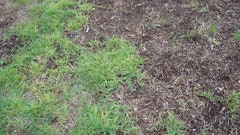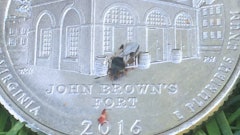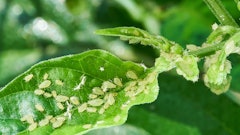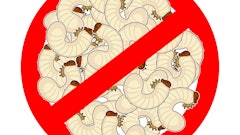
It's one thing to identify a lawn disease, another completely to prevent or eradicate it. Here's how lawn care operators can begin to do so for this season's top lawn diseases.
Dollar spot
Cultural prevention + control:
It's important to note that turfgrass deficient in nitrogen is more prone to infection and will recover more slowly. Therefore, lawn care operators should be sure to practice adequate nitrogen fertilization, balanced irrigation practices to prevent drought stress and avoid excessive leaf wetness and proper mowing height to encourage healthy turf growth are essential. Because dollar spot can also be spread in leaf tissue or clippings, operators should be diligent to wash equipment and dispose of clippings in between areas. Adjusting cultural practices to promote turf recovery, including reducing thatch and improving air circulation, can aid in restoring the affected areas.
Additionally, it's essential to avoid excessive thatch buildup and promote good air circulation to inhibit disease development. If overseeding, lawn care operators should consider choosing resistant cultivars or blends of multiple species whenever possible.
Chemical prevention + control:
Fungicides can be applied even before any symptoms are seen in turfgrass plants to knock the pathogen back before it takes over. Many contact and systemic fungicides are effective in controlling dollar spot, with preventive applications being the most effective. Begin preventive applications in the spring when nighttime temperatures are consistently above 50 degrees F. Be aware that the pathogen that causes dollar spot can develop resistance to fungicides very quickly, so lawn care operators (LCOs) should take advantage of the spectrum of effective chemistries and frequently rotate between fungicides with different modes of action. Fungicides must be applied at the high labeled rates and shortest application intervals when applied curatively.
Brown patch
Cultural prevention + control:
Brown patch infection requires continuous leaf wetness for at least 10 to 12 hours. LCOs should practice proper watering techniques, such as deep, infrequent watering in the morning to minimize moisture levels conducive to disease development. Avoid excessive nitrogen fertilization (no more than 0.5 pound N/1,000 square feet) during peak disease periods and maintain proper soil drainage and air flow. Aerating high-traffic areas in the fall will can also reduce compaction to prevent diseases such as brown patch the following year.
Chemical prevention + control:
Once brown patch is detected, immediate fungicide applications are necessary to stop the progression. Fungicides containing active ingredients such as azoxystrobin, chlorothalonil and fluoxastrobin are effective against brown patch, but regular monitoring of air temperatures and early intervention are crucial for successful control. Begin preventive applications when nighttime temperatures are consistently higher than 60 degrees F.
However, because of slower turfgrass growth rates and limited ability to recover from damage, lawn care operations should be aware that curative fungicide applications are not as effective during periods of hot weather.
Gray leaf spot
Cultural prevention + control:
To develop, gray leaf spot requires 14 hours of continuous leaf wetness. Lawn care operators should practice irrigating in the morning to allow foliage to dry during the day. Additionally, lush turfgrass produced due to excessive nitrogen is more prone to infection, so nitrogen fertilization should be limited in late spring and summer. As with other diseases, gray leaf spot can be spread from infected clippings, so be sure to thoroughly wash equipment and dispose of infected clippings. Note that perennial ryegrass is particularly susceptible to severe infection and should be monitored closely.
Chemical prevention + control:
Preventive fungicide applications should be initiated in mid-June to early-July and repeated on a 14- to 21-day interval. Fungicides containing active ingredients such as fluoxastrobin, chlorothalonil or thiophanate-methyl have been shown to effectively manage gray leaf spot. Application timing and coverage are crucial for optimal control. Gray leaf spot is known to develop resistance toquinone outside inhibitor (QoI) fungicides, so LCOs should rotate different modes of action for control.
If gray leaf spot appears, lawn care operators should begin immediate fungicide applications on a 14-day interval, combined with cultural practices to reduce moisture levels and enhance turf health, to help with disease suppression and turf recovery.
Rust
Cultural prevention + control:
Balanced fertility and a well-drained, healthy lawn will help deter high incidence of rust on turfgrass species such as Kentucky bluegrass and perennial ryegrass. Avoid irrigation during early evening to limit leaf wetness periods. Rust is a disease of slow-growing turf, so factors that contribute to slow turfgrass growth can lead to rust infections.
Chemical prevention + control:
Fungicides from the strobilurin and DMI classes of chemistry are effective against rust. Newly seeded stands can be susceptible to rust infections; these areas benefit the most from preventive fungicide applications.
Curative fungicide applications are also effective from the same chemical classes used for preventive applications. Small amounts of nitrogen fertilizer (0.2 pound/1,000 square feet) can also help control rust.
Fairy ring
Cultural prevention + control:
Healthy turfgrass stands will be able to grow out of disease infestations better than weak stands, so adequate moisture and fertility can go a long way to recovery. Catching the disease early before it progresses will provide improved control.
Chemical prevention + control:
Preventive applications of fungicides that include metconazole can provide fairy ring control and much better control of fairy ring symptoms than curative applications of any fungicide, but lawn care operators should take heed that the fungicide must be watered into the thatch/soil interface where the fungi reside. Preventive applications of QoI and succinate dehydrogenase inhibitor fungicides can be effective as well.
All of the mentioned treatments can be applied curatively, but they are rarely as effective as preventive applications. This is because if symptoms are already present, whether a fungicide is applied or not, the turf must grow out of these symptoms, which can take time.
Sources: Nathan Nordstedt, Ph.D., technical services manager, FMC Corp.; Andrew Osburn, Ph.D., technical services manager, FMC Corp.; Matt Giese, technical services Manager, Syngenta; Aaron Hathaway, technical services manager, Nufarm Americas


























